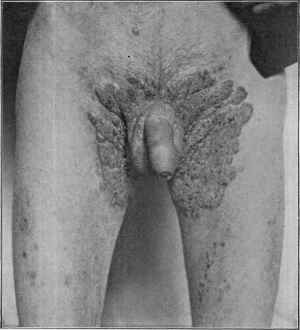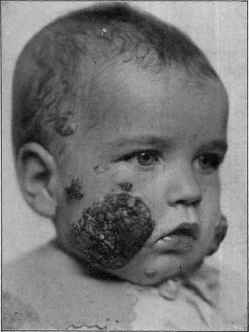| MEDICAL INTRO |
| BOOKS ON OLD MEDICAL TREATMENTS AND REMEDIES |
THE PRACTICAL |
ALCOHOL AND THE HUMAN BODY In fact alcohol was known to be a poison, and considered quite dangerous. Something modern medicine now agrees with. This was known circa 1907. A very impressive scientific book on the subject. |
DISEASES OF THE SKIN is a massive book on skin diseases from 1914. Don't be feint hearted though, it's loaded with photos that I found disturbing. |
DERMATITIS VEGETANS
A malady variously thought to be a modification, or subvariety,
of pemphigus vegetans as usually encountered, or as an entirely distinct
disease is that described first by Hallopeau,1 as pyodermatitis vegetans
(pyodermite végétante), and subsequently by Hartzell,2 Jamieson,
Fordyce, and Gottheil under the name of “dermatitis vegetans.” Later
Wende3 and Degroat reported 2 cases in children, and briefly reviewed
5 others (2 adults, 3 children) previously recorded, in which the same
peculiar vegetations developed upon an eczematous basis.
The cases of Hallopeau, Hartzell, and Jamieson in many respects
showed close clinical similarity to pemphigus vegetans (just described),
but the serious constitutional element was lacking, and the first eruptive
features were, predominantly at least, those of vesicles, vesicopustules,
and pustules, and not infrequently grouped as in dermatitis herpetifor-
mis. The vegetating plaques were amenable to antiseptic applications,
leaving behind some pigmentation, which finally completely, or almost
completely, disappeared. Hallopeau long maintained the individuality
of the disease and its non-identity with either pemphigus vegetans or
dermatitis herpetiformis; its relationship to the latter being asserted in
a report by Wickham,4 of a case presenting similar vegetating forma
tions, under the name of “Un cas rare de dermatite herpetiforme de
Duhring; variété pustuleuse et végétante,” and this belief supported
in the discussion by Vidal, Besnier, and Brocq. Although this case
may be probably accepted as an example of dermatitis vegetans, it
showed, as Hartzell states, “that his own case and those of Hallopeau
and Wickham, in which there were no blebs, but the eruption distinctly
1Hallopeau, Archiv, 1898, vol. xliii, p. 289, and vol. xlv, p. 323, and Annales,
1898, vol. ix, p. 969, and also in his treatise (Hallopeau and Leredde), Dermatologie,
1900, under “Pemphigus Vegetans, or Maladie de Neumann”; Pernet, “Dermatitis
Pustulosa Vegetans Recurrens,” Jour. Cutan. Dis., 1912, p. 517, records a remarkable
case (woman aged twenty-six), approaching more closely to Hallopeau‘s case than
to others, but getting well and then recurring.
2 Hartzell, Jour. Cutan. Dis., 1901, p. 465 (with illustration of genital region and
histologic cut); Jamieson, Brit. Jour. Derm., 1902, p. 407 (with illustration of hand and
histologic cuts); Fordyce and Gottheil, Jour. Cutan. Dis., 1906, p. 543 (with case and
histologic illustrations, review, and bibliography).
3 Wende and DeGroat, “Vegetating Dermatitis Developing During the Course of
Infantile Eczema,” (2 cases), Jour. Cutan. Dis., 1902, p. 58 (with illustration of face
and histologic cuts), and ibid., 1911, p. 743,4 cases with case illustrations; review, and
bibliography; Corlett, Brit. Med. Jour., Oct. 6, 1906, has reported a somewhat similar
case, but developing as a bromid-like papulopustular eruption.
4 Wickham, Annales, 1801, p. 1005; King Smith, “A Case of Dermatitis Vege-
tans,” Jour. Cutan. Dis., 1910, p. 605 (with a good illustration); rather unusual case;
in some respects similar to Wickham‘s; early condition suggestive of dermatitis her-
petiformis and some phases of pemphigus; nails of hand and feet fell off.
388
INFLAMMATIONS
pustular, or vesicopustular, with a marked tendency to occur in groups,
and, in some instances preceded by erythematous patches, to be much
more closely allied to dermatitis herpetiformis than to pemphigus”—
an opinion which Fordyce and Gottheil believe is also supported by their
case. That there are cases, however, in which such features, as well as
erythematous rings and gyrate patterns are conjoined with bleb-forma-
tion, is shown by the example recorded by Ormerod,1 concerning which
there was some difference of opinion as to its proper place—pemphigus
vegetans or dermatitis vegetans, Crocker viewing it as the latter. It is
to be said that Hallopeau, receding from his earlier stand, has recently
placed the malady as a variety of pemphigus vegetans. Jamieson
strongly maintains its individuality. The cases reviewed and reported

Fig. 92.—Dermatitis vegetans (courtesy of Dr. M. B. Hartzell).
by Wende and Degroat go to show that somewhat similar vegetations,
probably from some added infective agent, can also arise on the vesicular,
pustular, or oozing surface of such a mild disease as eczema, and seem to
point to the possibility that this peculiar vegetative tendency is not nec
essarily characteristic of any particular malady, but may be simply an
accidental or added feature to the several diseases named. Pusey,2
whose 2 cases of “vegetating dermatoses” are closely similar to those of
Hallopeau, Wickham, Hartzell, Jamieson, and Fordyce and Gottheil,
1 Ormerod, Brit. Jour. Derm., 1903, p. 26 (case demonstration).
2 Pusey, Jour. Cutan. Dis., 1906, p. 555 (with case illustrations); Perrin's 3 cases
(Annales, “Dermité végétante en placards chez les nourrissens seborrhoeiques," 1900,
P- 1055) have some features in common with both the Wende and Pusey cases.
EP1DERM0LYSIS BULLOSA 389
and yet apparently arising upon an eczematous basis, also takes this
view of the malady. In a few of the reported cases in children, some
times beginning as a papulopustule or pustule, the suggestion of a

Fig. 93.—Dermatitis vegetans (courtesy of Dr. Grover W. Wende).
bromid eruption is strong, but this seems to have been carefully
eliminated. As already intimated, cleanliness and antiseptic applica
tions are usually efficacious in its treatment.
But first, if you want to come back to this web site again, just add it to your bookmarks or favorites now! Then you'll find it easy!
Also, please consider sharing our helpful website with your online friends.
BELOW ARE OUR OTHER HEALTH WEB SITES: |
Copyright © 2000-present Donald Urquhart. All Rights Reserved. All universal rights reserved. Designated trademarks and brands are the property of their respective owners. Use of this Web site constitutes acceptance of our legal disclaimer. | Contact Us | Privacy Policy | About Us |